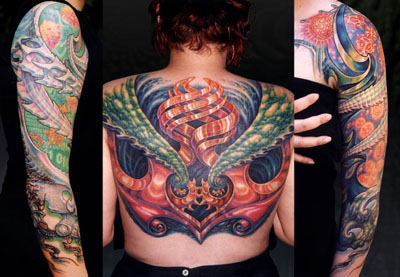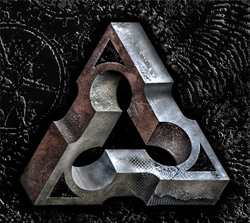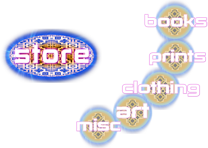Ask Guy 12 How Do I Educate Myself As A Collector
Q, from Dale: Hi Guy! I am a collector and have had 3 tattoos now for about 15 years. In the last year, I decided to update my current tattoos and add to them to create much larger more elaborate body pieces. This has also sparked more of an interest in the tattoo world as a whole. So, like any good collector of any kind of art form, I want to educate myself on my chosen art form. I want to learn history, different tattoo styles, and the artistic theories of tattooing such as saturation and line work. I'm just not really sure where to start without overwhelming myself. Can you suggest a good starting point and how to proceed with a thorough education? Hopefully, this will inspire other collectors like myself to actually learn about the art form that will be with them for life. Thanks so much!!!
A: Dale, I commend you on wanting to do your research more thoroughly. You are right that this could help you make better decisions about your collection in the future. However, by wanting to know such specific things about tattoo design principles, you sort of enter a gray area where much of the educational material that's been produced about these subjects has been designed for professional tattooists only. Most reputable retailers, including TattooEducation.com, will only ship such items to established tattoo studios. So unless you are actually wanting to learn tattooing and find a proper apprenticeship (see last month's Ask Guy column about this) then the question really is, what things do you need to learn to collect the best tattoo work? In today's column we'll focus on a few basic principles that should hopefully set you on your path as a large-scale tattoo collector armed with the right knowledge.
First and foremost is simply knowing what you like. This seems like a basic enough question but you'd be surprised by how many collectors start with some kind of concrete idea that they feel is so important at the time but ends up just seeming silly and in the way of larger plans as time passes and tastes mature. But it sounds like you already have a few pieces. So, the things you want to ask yourself are:
> Do I love all the tattoos I have?
> Do I especially dislike any of them?
> What is it about the work I've collected so far that has inspired me to start going large-scale?
You can ask yourself a lot more questions about your own tastes, but your own tattoo collection is a good place to start. Some collectors like to keep a file of favorite tattoos from magazines or pictures found online. Keeping this kind of "inspirational file" is not a bad idea, as long as you don't intend to copy any of the pieces but just want to draw inspiration from them. When you sit down with your artist you can show them your favorite work and say, "I really like the shading in this one... I like the way these belly scales curve... This one has a great color scheme." But remember that direct copying is bad mojo. If you're working with a good enough artist they should be able to look at your inspirations and then draw something custom for you that you'll like way more than any copied piece.

One thing that happens with many collectors is that they begin getting tattooed with the thought that each piece needs to signify something specific, or possibly many things. A common mistake is to cram all of your favorite symbols into one small tattoo with the though that it's be a better and better piece with more stuff included. But this isn't really the case- what you end up is compositional clutter, and most likely an artist who is annoyed with the project because, frankly, it's hard to make a great tattoo with a laundry list like that. So instead of listing a lot of symbols and elements, try to boil it down to a theme. For instance, it could be a nature theme, or a fantasy theme, or a dark theme, or a transcendental theme. Or you may be attracted to some hybrid theme- underwater biomech, or nature mixed with steampunk, or what have you. The bottom line is to come up with a theme that you can use as a way of keeping your collection consistent and visually balanced.
You don't necessarily need to limit yourself too much either- a single theme for a whole body is an amazing look but you may want more diversity. For example, I've known collectors who did one arm/chest/rib in a dark biomech theme, the other side in a luminous abstract theme. The trick is to find themes that are compatible so that they look right when seen side by side. A sleeve of black and gray portraits next to a sleeve of high contrast, full-color Japanese work might look imbalanced, with one side of the body carrying much more visual weight than the other. So diversity can be good, but only with attention paid to visual balance between your different themes.
Next comes finding the right artist or artists to do the work. This is easier today than ever, but you still need to do your research. One way is simply to do an online search: "Cleveland traditional tattoo artists" and other appropriate keywords. This will show you some options, but not all. Going to conventions, local or otherwise, is always a great option too- but if you are serious about doing your research and getting a carefully planned collection, resist the impulse to get unplanned work on your arms or other highly visible places. Treat your arms, chest and back as prime real estate that should only be developed with careful planning. If you need to collect random pieces, do it below the knee. Trust me, you can run out of skin fast.
One question is, are you willing to travel long distance for your work? If you choose to collect major pieces from artists in distant locations (as all of my clients do), many of these artists will be willing to work two or three days in a row. So although this kind of collecting involves traveling, the actual tattoo sessions are more focused and can be very productive. A sleeve can be finished in several visits this way, where if you were working with a local artist, you might break it into eight or ten visits. So your artist selection should include this consideration.
Whomever you choose should be someone who is perfect for your theme. They should have a portfolio with a lot of examples of work in the same bandwidth as the stuff you are wanting to collect. And you should be impressed with their technique. Since you are curious about proper lining and shading, this is really what it boils down to: Are you impressed with the lining and shading in their portfolio? If the answer is yes, then there is no need for you to understand the deeper technical tattoo principles behind that. These are things that should be our problem, not yours. But you should be able to recognize good work when you see it. Be sure the portfolio is consistent throughout- if there are some home runs but lots of fouls too, you might be taking a risk by getting tattooed by that person. There are a lot of great artists out there these days; if you do your research you will find them. All of us are happy to hear from serious collectors.
Last but not least, plan ahead. You don't need to plan your whole bodysuit before you put down the first outline, but having a strong sense of the direction you want to head with your collection can be very helpful. If you have a good theme or themes in mind and have found an artist that you click with who specializes in your theme, then the planning part should happen in discussion between the two of you. Talk about what you want to say with your tattoos, what you are trying to express. You may have only a very general idea, which is fine. Show them your favorite tattoos that they've done, plus really stand-out work by other artists if you want. Tell them specifically what you like about the pieces you show them, without asking for particular elements from those pieces. This will help them get a strong picture in their head without being burdened with a laundry list.
In my experience, these kinds of conversations can be great experiences, where the collector can dive deeper into their ideas and tease out the essential core of what they are wanting from their collecting experience. And for the artist, it can often lead to a clear visual picture of the project, often some exciting new twist on a familiar theme.
So if we were to break this all down to a list, here it is:
1) Know your tastes
2) Choose a good theme (or themes)
3) Find the right artist for you and your theme
4) Work with your artist in planning ahead and developing a road map for your collection
These plans should include working with any existing tattoos in a way that helps to create a unified overall look. This may involve a bit of rework, coverup, or possibly even laser sessions. But it's at the early stage of collecting that you might as well address these things. Often beginner's tattoo mistakes happen on the bicep or deltoid or forearm, right in the middle of your prime real estate. So be sure your planning addresses these concerns.
I hope this article has been at least somewhat helpful. You can learn a lot about the different styles and trends in tattooing just by looking online, reading magazines, checking out the occasional tattoo documentary, and simply paying attention. If you still find yourself wanting to know more about the art itself, perhaps you simply need to study art in general. Pick up a big fat art history book and dive in- that's a great place to start. It will make you see tattoos, and your tattoo collection, in a whole different light.























